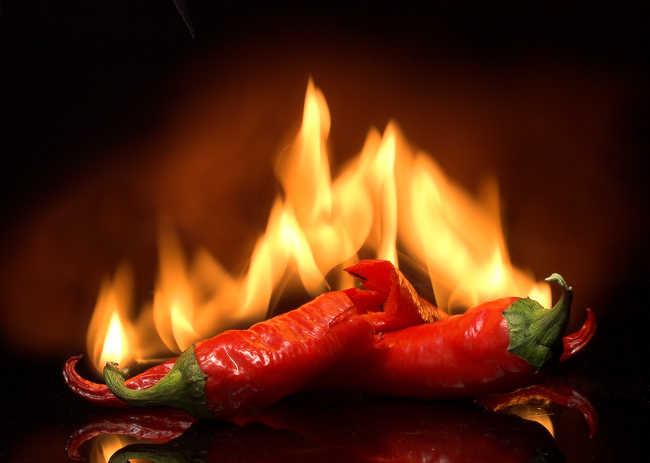 India and the American continent are its homeland, but today hot pepper is cultivated in various countries. He has many names: hot, hot, chili, bitter, just as many types of pepper, differing both in appearance and in their degree of burning.
India and the American continent are its homeland, but today hot pepper is cultivated in various countries. He has many names: hot, hot, chili, bitter, just as many types of pepper, differing both in appearance and in their degree of burning.
Content
Description and characteristics of hot pepper
In areas of domestic gardeners, this culture can not be seen often, although in recent years many have become interested in growing hot pepper. The reason is that traditionally Russian cuisine is not sharp, and for seasoning you can get by buying paprika in a supermarket. But now summer residents prefer to cultivate this pepper on their own, especially since, thanks to the variety of varieties, you can always choose fruits for seasoning, drying, and pickling with marinades.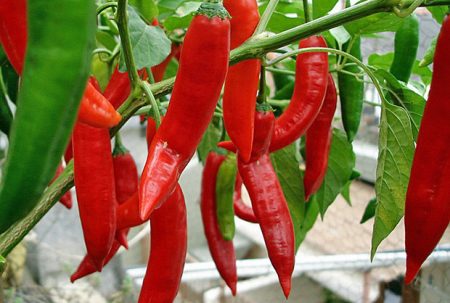
The plant is heat-loving, the bush is branched, the height can vary from 30-40 to 100 cm. Leaflets are egg-shaped, slightly pointed in the upper part. The color of the leaves depends on the type of peppers and variety, and can be light or dark green, olive, with a purple tint. In the bifurcations of the branches there are flowers - single, gathered in bunches, with corollas of white, grayish or greenish color.
The fruits of the plant are hollow berries with different shapes, shades, sizes. They can be in the form of pods - long or short, thick-walled and with a small thickness of the pericarp, narrow and wide. The variety and color of the peppers, and although the red pod is considered classical (in the phase of biological maturity), they can be:
- yellow;
- orange
- purple
- brown.
The peel of the fruit is either smooth or slightly “wrinkled”, and as for the degree of sharpness, there are even more variations.
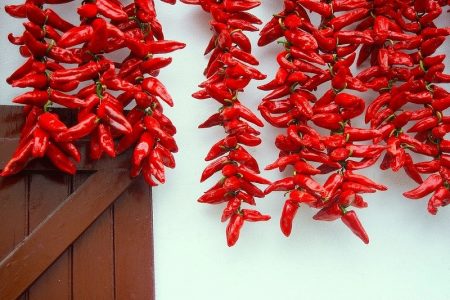
Peppers were classified by the amount of this alkaloid in them by the American scientist W. Scoville. There is a scale created by him, in which all the known hot peppers are divided into groups of "thermonuclear", that is, the degree of severity. There are burning varieties, medium-sharp, slightly sharp, sweet-sharp, and when choosing peppers for growing, you should pay attention to this characteristic. The degree of severity is always indicated in the description of the variety, although standard values are given. The thing is that the amount of capsaicin in the fruit can vary depending on the climatic conditions of the area, care, nutrition. Experts note that the same variety of pepper will have a different degree of hotness when grown in cool areas and in hot, humid regions.
There are a lot of types of pepper, and even more varieties, while more and more new options appear. A long and narrow paprika, taken fruits of habanero, chili crumbs and a huge number of peppers of various varieties that everyone can grow. By the way, hot pepper has varieties that, thanks to compact bushes, grow well indoors. So you can get both an indoor plant and a seasoning at the same time.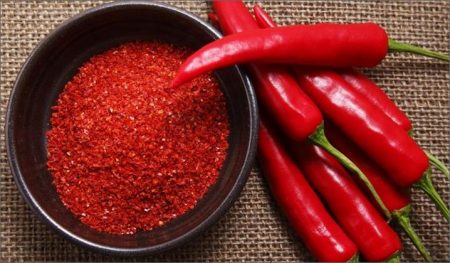
Properties
The use of hot pepper in cooking, as well as in medicine, cosmetology is due to its properties. In addition to the capsaicin alkaloid, its fruits contain a whole set of various vitamins, essential oils, minerals and enzymes.
Due to the large amount of vitamin C, pepper is considered a powerful antioxidant that inhibits the aging process of the body. Capsaicin, lycopene, vitamin P prevent the development of atherosclerosis, various tumor diseases, thrombosis.
To use pepper (of course, in limited quantities) is necessary to improve the functioning of all internal organs, normalize metabolism. Pepper helps improve vision, the condition of the skin, nails, hair, and, if necessary, increases the level of hemoglobin.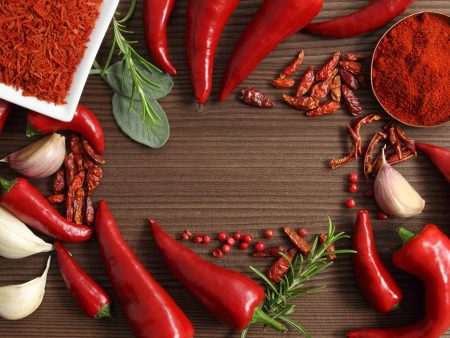
Hot pepper - a spice that has a very beneficial effect on the pancreas, the entire digestive tract. Spices increase appetite, while at the same time pepper is used in various diets for weight loss. It is widely used in various folk recipes, and is also part of the medication.
But we must keep in mind that the degree of sharpness of the fruit can be different, so always trying these peppers, you must be careful and accurate. There are varieties in which the fruit walls are even sweet, and all the acuity is "hidden" in the seeds and septum, there are completely burning peppers. When adding pepper as a seasoning, you must always know the grade, the severity, otherwise you can earn a mucous burn. And never drink water with a “fire” in your mouth (if you tried a very hot pepper), this will not help. It is better to drink milk, drinking yogurt, eat a piece of bread.
Varieties of Hot Peppers
The choice of peppers is simply unbelievable, and gardeners are gambling people, I want to grow everything at once. But you need to know some features of the culture and take them into account when choosing seeds:
- Be sure to specify the grade according to the degree of severity. Think about why and where you will use the fruits of pepper: in cooking, for medicinal purposes (for example, for tincture), or you are attracted to the decorativeness of the plant.
- An important indicator is the yield of the variety. Often quite a couple of bushes of hot pepper are enough to provide seasoning for both your family and all relatives.
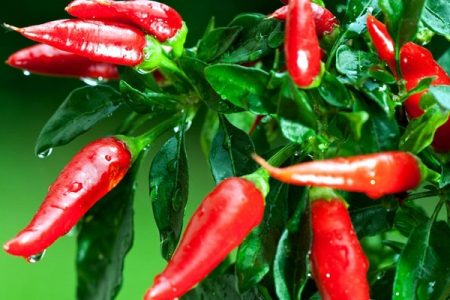
- Consider the ripening period of fruits of a particular variety. For cultivation in our Russian conditions (we are not talking about the southern regions) early varieties are best suited.
- Do not forget about such a characteristic of pepper as the height of the plant. For open ground, as well as growing in pots, compact varieties are suitable at home, while tall peppers can be planted in the greenhouse.
- If you plan to dry the pods, then choose thin-walled varieties. For salting and marinades, the fruits of thick-walled peppers are suitable.
The review contains varieties of hot pepper, which are successfully grown by our domestic gardeners.
Miracle of Moscow Region
An early ripe variety is best grown under shelters, although it grows well in ridges. The bush is tall, but there are few leaves on it. Peppers - pods, long, drooping, about 22-25 cm long. By weight they reach about 30-50 grams. The walls are thin, so the fruits are great for drying.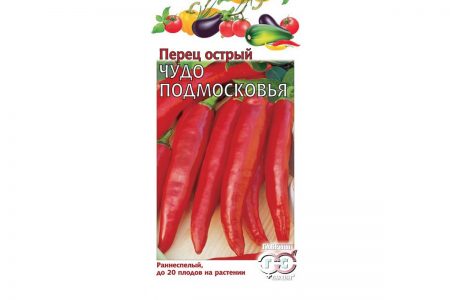
The taste of the fruit is pleasantly spicy, there is no particular pungency, but the variety has a very strong bright aroma.
Gardeners rated the Miracle of Moscow Region for their unpretentiousness, early ripening of peppers, and productivity. On one bush, up to 18-20 peppers can ripen at the same time. They are suitable for salads, drying, as well as for whole preservation. From one square meter of planting, you can collect up to 4 kg of fruit, which is a very good indicator.
Jalapeno
On a tall, about one meter tall bush of this variety of pepper can grow up to 25-30 fruits.The birthplace of this hot pepper is Mexico, but today culture is also cultivated on other continents.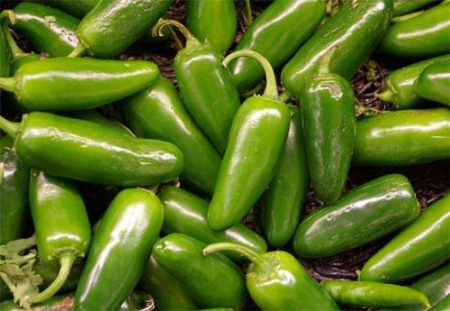
Domestic hot pepper lovers like the variety for productivity, a high degree of burning fruit. It should be noted that Jalapeno peppers in a state of technical ripeness (green) are more burning than ripened red fruits. Mexicans use green jalapenos to make their legendary chipotle seasoning.
The fruits of the variety are thick, elongated pods up to 8–9 cm long. In Russia, this variety is usually cultivated in greenhouses and greenhouses. A sufficient amount of heat and moisture is required, since with insufficient watering the plant discards its color and ovaries.
Habanero
This variety of pepper is considered one of the most burning, at the same time, the aroma of sweets, citrus and fruits is present in the fruits. Habanero is unusual not only in taste, but also in appearance. Its fruits - small “crumpled” peppers in the form of hearts have red, cream-white, orange, yellow or dark purple color. The mass of "hearts" is about 20 grams.
The degree of pepper acuity is different, for example, in white Habanero pods have a slightly sweetish taste without bitterness, but in Red Habanero from California or from the islands of the Caribbean, hotness is off scale.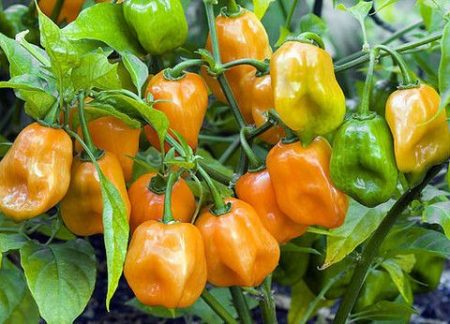
The variety is characterized by excellent yield, a large number of fruits can be formed on the bush. Habanero is suitable for growing in pots, while you need to provide plants with abundant regular watering.
Astrakhan 147
One of the most famous varieties in Russia is Astrakhansky burning pepper 147. It grows well in open ground and produces good crops in different regions of the country.
The bushes are very compact, stunted, reaching a height of no more than half a meter. There are many fruits on the plant, all of them are drooping cones weighing up to 8-10 grams. The pods are long, up to 9 cm, with thin walls, glossy and smooth. In terms of ripening, this variety is mid-ripening, it will take about 120-122 days to ripen the fruit (technical ripeness). At first, the pods have a saturated green color, later they become bright red.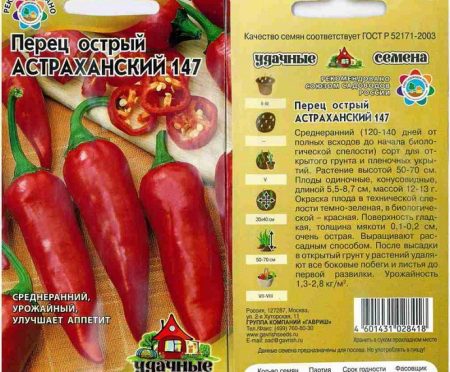
The yield indicators are good, you can collect up to 3 kg per square meter.
The fruits of the variety are used for drying, as a seasoning, for preservation and marinades.
Double abundance
The name of this variety of hot pepper speaks for itself, it is indeed very productive. It can be grown on ridges, but gives the best results in a greenhouse, where it bears fruit in several tiers.
It is required to follow the scheme of planting bushes, planting no more than three plants per square meter. On the bush, up to 35-45 fruits, long trunk-like pods ripen. On average, the length of the peppers is up to 21-22 cm, weight - about 70-80 grams. The walls are thick, so this variety is less suitable for drying, but it is very good in salads and for canning.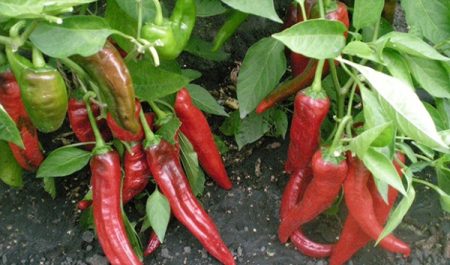
At the same time, if the peppers are properly dried, they are perfectly stored for several years, without losing their appearance and taste. Variety features: early ripening and long fruiting, resistance to many diseases, resistance to drought.
Burning bouquet
If this variety of hot pepper is sown for seedlings in mid-February, then after about 110 days it will be possible to collect green pods of hot pepper. Variety Burning bouquet will please with good productivity, unpretentiousness.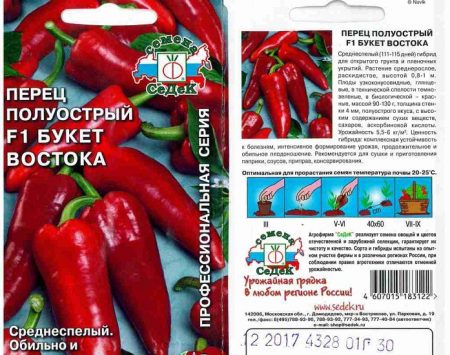
It is suitable for growing in greenhouses, a greenhouse, in open ridges, so it is successfully cultivated by summer residents in various regions of Russia. The variety is productive, resistant to disease.Bushes grow up to about 70 cm, fruits - drooping pods weighing up to 3-4 grams. The walls of the cone-shaped pods are thin; the fruits are excellent for drying and preparing powder. The taste of peppers is semi-sharp, with spicy notes.
The variety is used fresh, for drying, as well as for any marinades.
Chinese fire
On a spreading bush of this variety of pepper, up to 30 long pods of bright red ripen. Hybrid Chinese fire is characterized by high severity, abundant fruiting, and resistance to a number of diseases.
The height of the bushes is up to 60 cm, gives the best harvests in film shelters. Fruits - pods up to 23 cm long, by weight - 50-70 grams.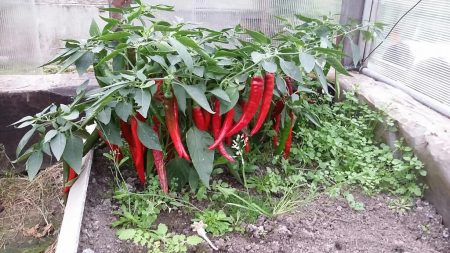
This hybrid is included in the State Register of the Russian Federation, recommended for cultivation in all regions of the country. In terms of ripening - mid-season hybrid, requires proper care, but it is very stable in yield.
The fruits are used for drying, canning, very tasty in marinades.
Trinidad small cherry
An interesting variety of peppers is Trinidad Small Cherry, the fruits of which have a spicy-spicy taste with a cherry aroma. This is a very early pepper, the fruits of which can be removed as early as 70-90 days after germination. But for consumption, the fruits must fully ripen, since the pepper acquires the true taste and aroma only in a state of biological maturity.
The fruits of Trinidad Small Cherry are round “berries”, very similar to red cherries (green in an unripe state). The fruit mass is small, in size in diameter the peppers reach about 2-3 mm.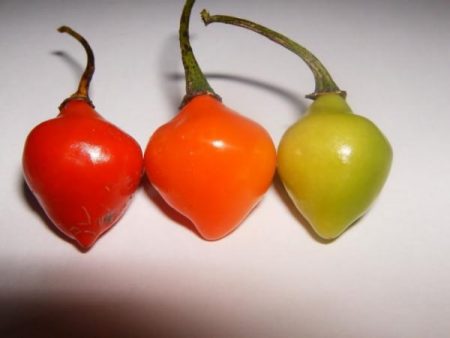
The variety is used for seasoning, and can also be grown as an ornamental plant for decorating interiors.
Indian elephant
The Indian Elephant variety, with its name, recalls exotic Indian cuisine. However, in Russia there are many lovers of spicy dishes, so we recommend trying to grow this peninsula.
Bushes in it reach a height of about 60-70 cm, plants are compact. Fruits are first green, and then, as they ripen, acquire a bright red color. The surface is smooth, with a strong gloss. The pods are elongated, weighing about 23-25 grams.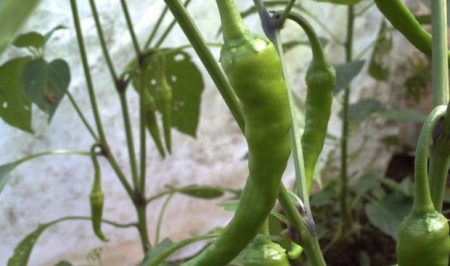
Productivity is good, in terms of ripening, this variety is mid-ripening (up to 130 days). Up to 3 kg of peppers are usually collected from one square meter (subject to proper agricultural practices).
The fruits are used fresh (added to various dishes during cooking as a seasoning), they are also suitable for canning.
Cayenne red
The variety belongs to the group of hot cayenne peppers, which are distinguished by high stiffness and elongated fruits. The bushes are high, during the fruiting period they are strewn with numerous pods.
The ripening of fruits is uneven, so on one plant you can see green, slightly reddish, dark red (ripe) peppers. Cone-shaped pods have a length of 12-13 cm, their diameter is small, the walls of the fruit are thin. The skin of the pods is smooth, shiny.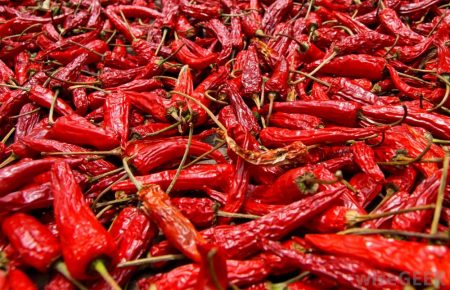
The variety is suitable for the preparation of seasonings, marinades, and is used for preservation.
Which varieties to choose is the business of every gardener, since many different factors must be taken into account. But varietal variety will allow you to choose any variety, ranging from spicy and ending with "fiery" peppers.
Hot Pepper Growing Rules
There are no particular difficulties in growing this crop. But there are some rules that are recommended to be followed in order to get a good harvest.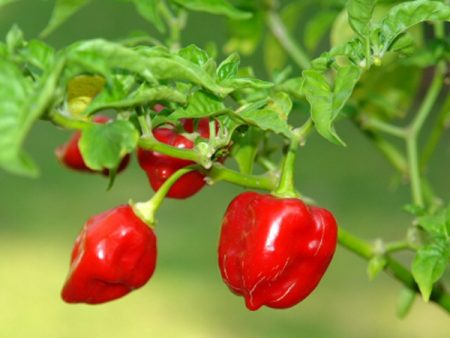
- It is necessary to correctly determine the time for sowing seeds of hot pepper for seedlings. Usually they are sown from mid-February to the end of March, but they take into account the characteristics of the variety, as well as their own conditions (the climate of the area where the pepper will be grown).
- Peppers do not tolerate transplantation, so it is better to do without diving and immediately sow it in separate containers. Glasses are suitable - plastic, paper, peat pots.
- Sprout pepper seeds at a temperature of + 25ºC ... + 28ºC, but as soon as the sprouts appear, you need to lower the temperature to + 18ºC (about five days). This is done so that the hot pepper seedlings do not stretch.
- The soil must be nutritious, moisture permeable.
- Hot pepper, like his fellow Bulgarian, loves heat and moisture very much. Therefore, during the cultivation of seedlings on the windowsill, it is necessary to allocate him sunny places, to get rid of possible drafts.
- 10 days before you plan to transplant hot pepper into the greenhouse or in the beds, begin to take it to fresh air. First, for 15-20 minutes, then you can increase the time. Such hardening will only benefit plants that take root more quickly in a new place and will be less sick.
- The first color bud must be removed. This stimulates the formation of subsequent ovaries.
- It is required to observe planting patterns, while sweet peppers should grow far from burning varieties.
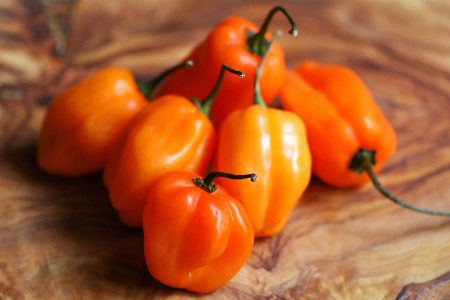
- Peppers are watered regularly, preventing the soil from drying out. In this case, you can use such a technique as the “fright” of peppers. To do this, you can take a short break in watering to create stress for the plant. This contributes to the accumulation in the fruits of more capsaicin (if you want to grow more hot peppers).
- You can take fruits when they reach a state of technical ripeness. At this time, the peppers were still green, but had already formed in mass and length, acquired the necessary condition. They can be removed to stimulate subsequent flowering and the appearance of new ovaries. The fruits ripen perfectly at home, and the plant continues to bear fruit further.
- Thick-walled fruits are usually used for seasonings, additives in salads. Peppers with thin pericarp are ideal for drying (they can then be ground into powder), for marinades, preservation. Mistresses often use long hot peppers as an additive in assorted dishes with cucumbers and tomatoes, where they add the desired spiciness and piquancy to vegetables.
With good care, the culture will certainly thank you with a good harvest, and who knows, maybe next year another two or three varieties of hot pepper will appear in your garden.
Reviews
Nadezhda, Rostov-on-Don
I planted the variety Miracle of the Moscow Region, I really liked the description and photo of the variety. It was written that it was a weakly sharp pepper, but I had none. The bushes grew tall, there were a lot of peppers on each one (that is, it is good in yield), but there was no sharpness in the fruits at all. Next to it there was a hot pepper of another sort, which, as expected, was burning. And this one is not. His fruits are beautiful, I took pictures, and they matured well at home. The skin is tough, the color, of course, is bright, red. But that’s all, there are no other advantages. Therefore, I cut it into slices in marinades and pickles, only for beauty. I have to grow another variety, I’m disappointed in this.
Inna, Vologda Oblast
Last year we experimented with Jalapenos. An excellent variety that grows without much care (well, at least it seemed to us very capricious), and gives good yields. We pickle it with green, it turns out so tasty that you just lick your fingers. Sharp in moderation, well, maybe he’s cool with us and therefore not so hot. The red peppers that ripened were spicy, pleasantly sharp, the green ones were more burning.
With us they came up very well, were grown in a greenhouse, and a couple more bushes grew in exhaust gas. Next year I’m only planting him; my husband ordered more marinades.
Oksana, Tyumen
I wrote out Habanero pepper. A sharp, yellow miracle has grown. I tried the first ripened pepper, I thought it would be more spicy. But it turned out that this is only the tip, but the base is very burning. Everything burned in me - both tongue and lips. I use for marinades, as a seasoning. They say that the fruits are even smoked, and not just dried.




 Calorie pepper stuffed with meat and rice - BZHU per 100 grams
Calorie pepper stuffed with meat and rice - BZHU per 100 grams Gorky pepper - the best varieties for open ground
Gorky pepper - the best varieties for open ground Hot pepper seeds - the best varieties for open ground and reviews
Hot pepper seeds - the best varieties for open ground and reviews Capsicum tincture for hair - how to use and reviews
Capsicum tincture for hair - how to use and reviews